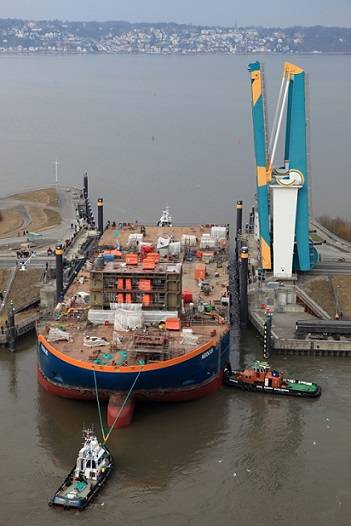German-built Jack-up Vessel for Offshore Wind Farms
The hull is complete, the steelwork concluded, the building of the deckhouse has begun – in the dock of Sietas shipyard the first jack-up vessel for offshore wind farms developed and constructed in Germany is currently taking shape. Construction started in April 2012; the handover of the ship to the client, the Dutch marine engineering company Van Oord, is planned for July of this year. For further work on the final assembly, the jack-up vessel needs to be floating in the dock harbor of the Sietas shipyard. For this reason, it has now been undocked with an elaborate change in position, and its former construction platform has been removed from the dock harbor.
Sietas insolvency administrator Berthold Brinkmann said, “The jack-up vessel demonstrates the outstanding performance of the Sietas shipyard and its team. During the insolvency proceedings, a highly complex special purpose ship for demanding offshore wind farms is taking shape as a result of the contract between Van Oord and the insolvency administrator. Sietas also developed this ship itself. This is unique for a German shipyard and underscores the globally competitive know-how of the engineering, construction and work output that this shipyard offers.”
Undocking from the dock harbor for final assembly
Up to now the jack-up vessel lay on a construction platform in the dock harbor of the Sietas shipyard. Dr Ludwig Reichert, authorized agent of the insolvency administrator, explained, “The ship’s hull is now complete, the steel work concluded and the building of the deckhouse has begun. With this, the load-bearing capacity of the construction platform had been reached with around 12,500 tons. For the concluding final assembly the 140-metre-long ship must now float in the water of the dock harbor of the shipyard.”
For this purpose a switch in the position of the ship was necessary through the Este dam structure bordering the dock harbor to the rivers Este and Elbe. First the water tanks of the construction platform were filled so that the platform could be lowered. With the incoming tide the ship then started floating. In the next step it was towed by tugs out of the dock pit and hauled through the Este dam structure. This required precision work, because at 38 m the jack-up vessel is barely narrower than the gate of the dam structure with 40 m. Afterwards, using a tow up the Elbe, it was securely parked at a quay in the Hamburg harbor. In the next step the water was pumped out of the tanks of the construction platform, so that the platform also floated and could be towed out of the dock harbor. Finally, the jack-up vessel was then again towed through the Este dam structure into the dock harbor and now lies afloat in the water for final equipping and its initial commissioning at the Sietas shipyard.
Status of construction and next steps to be undertaken
The Sietas team is currently working on the special purpose ship in a three-shift system. Approximately 400 workers were involved in the especially intensive construction phase. “In just six weeks we built the afterbody and the forebody out of nine blocks – a top achievement by the team in such a short period of time,” explained Oliver Arnold, Sietas shipyard project manager for the jack-up vessel. The four heavy rudder trunk blocks, in which the stilts are held, with which the ship can later raise itself out of the water while working at sea, were also produced at the shipyard. “Our workers were classified for the construction of the jack-up vessel for offshore structures and thus are among the few in Germany who can work with offshore steel. With the construction of the ship we are showing that we master the right mixture of industrial production skills such as assembly, special technical skills and highly technological engineering,” said Martin Stolzenberger, head of final assembly and commissioning of the ship at the Sietas shipyard.
In the coming weeks, among other things, the deckhouse bridge from which the ship is controlled will be further set up, the expanded leg guides for the stilts will be installed and the offshore crane that can lift 900 tons will be erected with its foundation, pillars and booms. After this work has been concluded, the ship will leave the shipyard at the end of June for its first trial voyage. Construction at the Sietas shipyard is then concluded. The ship is unlikely to receive its four stilts, with their length of 84 m each and corresponding “shoes”, until after the first trial voyage at sea outside the shipyard due to the special dimensions of these components.
The Sietas shipyard also developed the jack-up vessel in cooperation with the client, Dutch marine engineering company Van Oord. The crane was built at the former Sietas subsidiary Neuenfelder Maschinenfabrik (NMF), now belonging to the TTS Group. The construction of the jack-up vessel involves close cooperation between the Sietas shipyard and Van Oord; a team of about 20 engineers, experts and project managers from the client firm, which specializes in complex offshore projects, is on-site during the formation phase at the Sietas shipyard.
About the jack-up vessel
The Sietas jack-up vessel ship is known in the industry, was developed for use in offshore wind farms. It has a transport capacity of up to 6,500 tons and can work safely in water depths of up to 45 m. It can load itself, has DP2 equipment (Dynamic Positioning System 2) that positions it very precisely, keeping it stable even in heavy seas, and a jacking system with four stilts that are 84 m long, each weighing around 900 tons and with a diameter measuring 4.50 m. This allows it to lift itself far above the surface of the water and ensures a secure working position for installation tasks.
The ship is 140 m long and 38 m wide, its molded depth amounts to 9.12 m, its draught to 5.70 m. Its speed during service is 12 knots. The diesel-electric drive with four sets of generators achieves a total of 10,000 kilowatts. The special offshore crane can lift a 900-ton load with a jib reach of 30 m and work at a height of about 120 m above the water. The installation ship will accommodate 74 crew members during its deployments on the wind farms.











